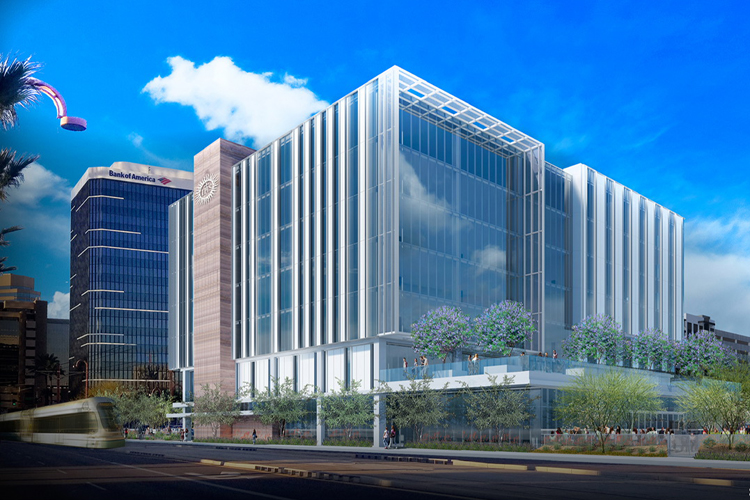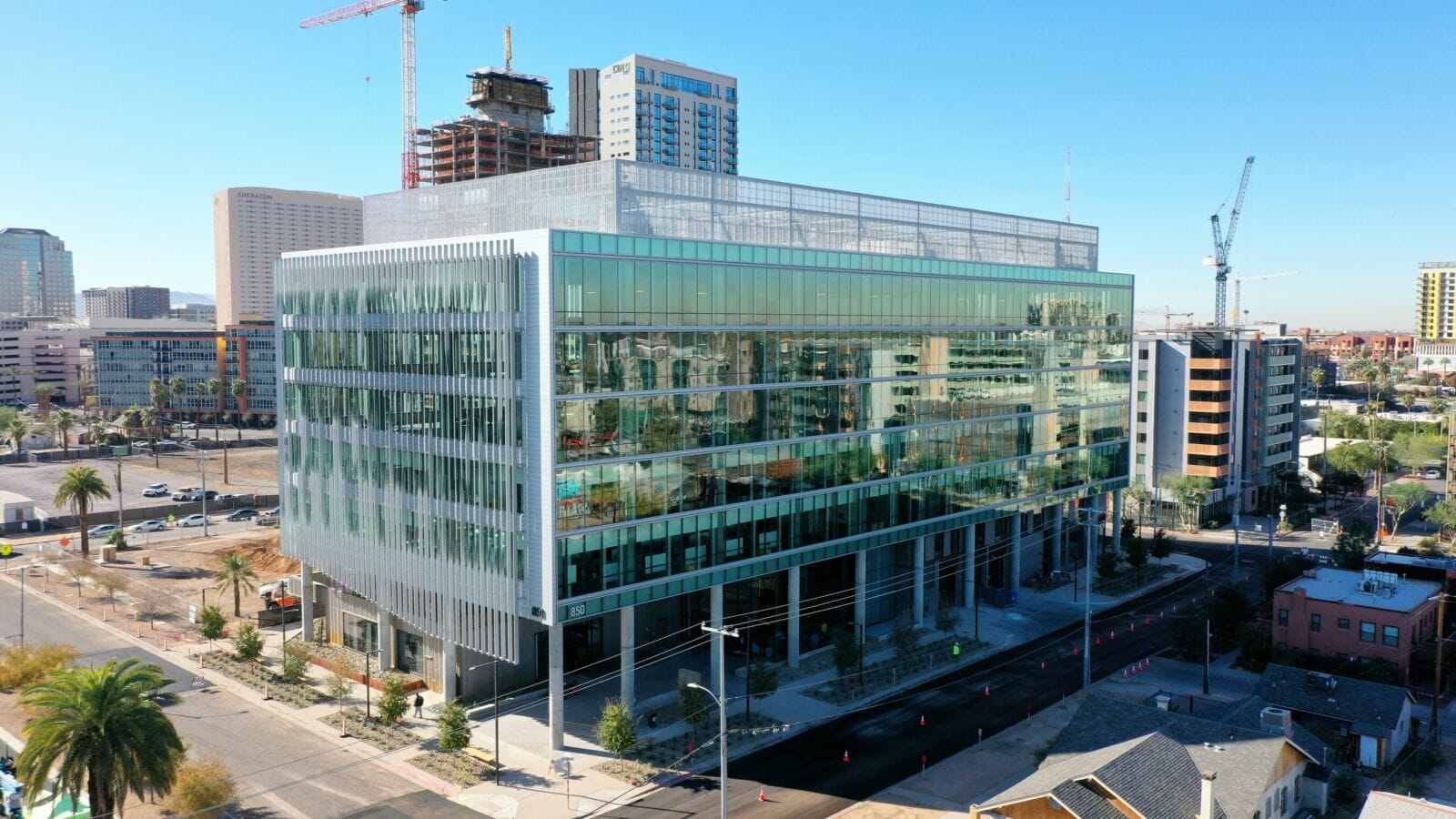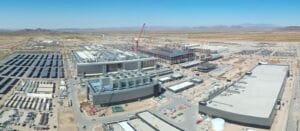In recent years, Arizona has seen rapid growth in its population, its bioscience sector, and its healthcare infrastructure. The momentum is continuing to build — especially when it comes to Arizona bioscience construction and building.
Like the sciences they support — these structures are the result of studies being conducted, long term planning, and expert implementation over time.
LEARN MORE: 2023 AZBio Awards and 20th Anniversary Celebration
DEEPER DIVE: Phoenix designates Park Central as its newest bioscience hub
“Over 25 years ago, leaders in Arizona came together to build a bioscience sector,” says Joan Koerber-Walker, president and CEO of the Arizona Bioindustry Association (AZBio). “In 1997, the state designated the biosciences as one of Arizona’s key economic clusters and the community began to plan.”
In 2000, Governor Jane Dee Hull rallied the community around Prop 301 (Education 2000). Approved by Arizona voters, Prop. 300 created a 0.8% sales tax designated for education. A small fraction of what is collected goes to the Technology Research Initiative Fund (TRIF) to fund research at Arizona universities. Those fractions of a penny add up. Today over $1.8 billion in TRIF dollars has funded research at Arizona State University, the University of Arizona, and Northern Arizona University.
To build the places where this university led research happens, the State of Arizona allocated $500 million in 2003 and approved an additional $1 billion in 2017 to buildup and maintain its research infrastructures at Arizona’s three state universities.
In 2001, Dr. Jeffrey Trent was serving as the founding Scientific Director of the NIH Institute overseeing the world’s largest collaborative biological undertaking— the Human Genome Project—a 13-year effort to determine the complete sequence of DNA bases in the human genome. But how could this information be applied to make a real difference in people’s lives? He envisioned an institute that would translate the blueprint for understanding human biology to advance the diagnosis and treatment of various cancers, neurologic, and metabolic diseases, such as Alzheimer’s and diabetes. This vision would be realized as the Translational Genomics Research Institute or TGen. In the summer of 2003, the community came together to break ground on a six-story, $46 million facility to house TGen laboratories and administrative offices on the newly designated Phoenix Bioscience Campus or PBC.

Phoenix Bioscience Core
The PBC, now called the Phoenix Bioscience Core, was the first of a series of real-estate investments by both public and private entities that have helped to develop bioscience hubs around the state. The PBC already includes over 2 million square feet of research, healthcare, and education infrastructure and is planned to grow to 6 million square feet.
Phoenix now has two more major bioscience and healthcare hubs, the Discovery Oasis to the north and the newly designated Phoenix Medical Quarter in midtown. Phoenix is recognized as a global leader for life science innovation. In 2021, the City of Phoenix ranked #5 in Emerging Life Science Markets and #1 in Life Science Job Growth. From 2019 to 2023 there have been over $4 billion in capital investments, over 6 million square feet of primary facilities developed, and over 10,000 jobs created.
The Phoenix Bio Hubs are home to the state’s largest industry concentration including Bristol Myers Squibb, Caris Life Sciences, Castle Biosciences, Exact Sciences, GE Healthcare, LabCorp, SonoraQuest, SCHOTT, W.L. Gore, and more. The hubs include major facilities from the state’s four largest healthcare delivery systems as well as world class clinical research sites including Arizona Heart Hospital, Banner Alzheimer’s Institute, Barrow Neurological Institute, Norton Thoracic Institute, Phoenix Childrens Hospital, and the University of Arizona Cancer Center.
Scottsdale is home to the Cure Corridor. Here you will find the Skysong Innovation Center, the Ilume Innovation Center, major campuses for CVS Health, HonorHealth, and Mayo Clinic, as well as a number of medtech companies including AdviNow Medical, GlobalMed, Regenesis Medical, TD2, and more.
Tempe’s hub is home to the Biodesign Institute on Arizona State University’s main campus and a thriving medtech cluster including Becton Dickinson (BD), GT Medical Technologies, Medtronic, Schott, Stryker , and others.
In the north, Flagstaff’s hub includes Northern Arizona University, the region’s largest private employer, W.L. Gore, TGen-North, and incubator, accelerator, and manufacturing space for small companies at NACET.
Greater Tucson’s hub is anchored by the University of Arizona and includes the BIO5 Institute, University of Arizona Health Sciences, and the University of Arizona College of Medicine-Tucson. The hub is home to industry leaders including Accelerate Diagnostics, Bayer Crop Sciences, BD, HTG Molecular Diagnostics, Roche Tissue Diagnostics, SynCardia, and more.
“TGen was a catalyst for the growth of our community’s interest in building Arizona’s bioscience capabilities and capacity,” shared Koerber-Walker. “Conversations led by Dr. Tent and other community leaders brought people together, captured their imagination, and spurred them to action.”
A long-term strategic plan
The Flinn Foundation is a privately endowed, philanthropic grantmaking organization with a mission to improve the quality of life in Arizona to benefit future generations.
The increased funding and interest in biosciences led Flinn to convene the community and to provide the funding to create a “Bioscience Roadmap” for how bioscience development in the state would work in 2002.
“Today, Arizona’s Bioscience Roadmap is the largest and longest permanently managed strategic plan to build a bioscience center anywhere in the country” according to Koeber-Walker.
Flinn’s Executive Vice President Brad Halvorsen explains the roadmap as a SWOT (Strengths, Weaknesses, Opportunities, Threats) analysis commissioned by Flinn and conducted by Battelle and later TEConomy Partners.
“Flinn Foundation commissioned this partly because Flinn had an interest in becoming very involved in biosciences development in Arizona,” Halvorsen says, “So we commissioned the study to help inform us where the opportunities were.”
The Roadmap features five overarching goals, as well as strategies and potential actions, that will help the community reach these goals.
Direction for industry
The Roadmap report emphasized that collaboration was an essential requirement of building the state’s bioscience industry.
“It became more of a statewide collaboration amongst academia, companies, government, elected officials, investors, and the various walks of life that make up the biosciences,” Halvorsen continues.
The report also highlighted the importance of creating clusters or hubs where researchers, clinicians, and industry are collocated to foster collaboration.
“The strategy of having a cluster is having the different disciplines that make up bioscience close together, so they can get to know each other, work together, and leverage what they can do through their mutual support,” Halvorsen claims.
Koerber-Walker echoes these sentiments, specifically identifying that a lot of clusters tend to take root around a “key asset”, noting a few examples in Scottsdale. “Mayo Clinic and Honor Health both have research and teaching hospitals in Scottsdale,” Koerber-Walker says. “You see bioscience companies develop around those hospitals because health innovation starts with research, moves into o development, and then on to healthcare delivery.”
Arizona bioscience construction delivers care
The amount of infrastructure needed to deliver healthcare services to the people who need it is population driven. The more people you have in a state, the more facilities you need to care for them.
Arizona’s population grew from 5.161 million people in 2000 to 7.421 million according to U.S. census data. One national standard for measuring healthcare infrastructure is the number of staffed beds. Today, the average ratio of staffed beds to 1,000 persons in the U.S. is 2.37.
From 2000 to 2021, Arizona’s hospitals and community health centers added over 4,200 beds. To put that in perspective, Banner University Medical Center in Phoenix is the state’s largest hospital with 755 staffed beds. The number of new staffed beds that were created is the equivalent of more than 5 hospitals that size. Even with this level of healthcare infrastructure growth, Arizona’s 2021 ratio of 2.03 beds per 1,000 people demonstrates that we may need another 2,500 staffed beds to support our current and growing population.
Arizona’s major healthcare systems are investing to create more healthcare infrastructure in communities to meet the population’s healthcare needs.
More healthcare infrastructure creates more demand for the healthcare professionals that work within the facilities. This includes doctors, nurses, therapists, technicians, counselors, administrators, facility staff, and more.
“Bioscience is intertwined with healthcare and the issue in healthcare is having a sufficient number of doctors to support our growing populations. There’s a need for future positions in our state but there’s also a lot of research that takes place in medical schools and that can spawn new ideas and new enterprises as well,” he says.
Koerber-Walker mentions, “when I first moved to Arizona in 1993, we had one medical school in the whole state and that was at the University of Arizona in Tucson.”
In 2023, there are six accredited medical schools in the state. The recent announcement of a planned medical school at Arizona State University will bring this number to seven.
These medical schools are helping to address the shortage of physicians currently operating in Arizona. Halvorsen maintains that it will not only address this goal but also contribute to the bioscience ecosystem as a whole.
Developing and constructing bioscience buildings, hospitals, and medical schools requires specialists.
“The construction of life sciences buildings is very complex, like the living organisms that they study,” says Andrew Gillett, vice president of preconstruction at McCarthy Building Companies.
While not involved in building the upcoming medical school, McCarthy has created other bioscience structures for ASU including ASU Biodesign C and the Walton Center for Planetary Health (formerly known as Interdisciplinary Science and Technology Building #7.)
“These buildings have a number of different components so the teams that design and build them are made up of representatives from many different disciplines who have to work together in concert to achieve a functional outcome that accommodates many different kinds of research,” Gillett says.
Taking all that research into account, this leads to a much larger team of consultants than is usually present for an average building. Gillett mentions the University of Arizona having specialized ventilation systems in bioscience buildings due to the mechanical requirements each room had. The modifications are necessary because everything in the building has the potential to impact the next room over. This leads to the buildings being rather expensive to design. Gillett projects between $500 million and $1 billion will be spent building new research facilities on Arizona’s university campuses in the next five years.
In addition to specialized design needs that accommodate research and safety requirements, additional features are included to support attracting grants, tenants, and research projects to universities.
For example, McCarthy was involved in the creation of the Biodesign C building. This one-of-a-kind facility had specialized design needs to accommodate the world’s first Compact X-ray Free-Electron Laser, or CXFEL. This system allows researchers to see things that cannot be seen with conventional X-rays. The instrument will let scientists see inside molecules, helping them create more effective drugs.
Looking ahead
When it comes to Arizona bioscience construction, different types of research programs can have different infrastructure needs. A building must be designed so it can be adapted to meet them. Gillett mentions that buildings are designed and constructed so that they can be adapted to meet future research requirements.
“Specifically, when you’re doing research projects that are grant-funded, many of them come from federal grants. That research lasts for a period of time,” Gillett says. “When that study is done, a new type of research will take place in that same environment. So, the buildings are built with future flexibility in mind.”
Longevity is also a factor in the design process according to Gillett, “A lot of planning and coordination takes place in the design phase to be sure we have an outcome that supports research for 50-75 years in the future.” Gillett says remaining flexible throughout the process is key. “Whatever we do, it’s gonna change, but it always changes for the better.”
Arizona is still an emerging bioscience state, but thanks to infrastructure expertise that has been developed during these two decades of ecosystem growth, the process has been expedited significantly.
“We’re still in the growing phase, but we’re growing quickly,” Koerber-Walker says of Arizona bioscience construction and the state’s bioscience and healthcare infrastructure.
Today, Arizona bioscience hubs are key economic drivers and job creators contributing over $38.54 billion in economic impact in 2021. Organizations from all over the country are conducting research at Arizona universities. The level of clinical trials and research programs at Arizona hospitals is steadily growing. Global industry leaders are designing and manufacturing innovative medical devices and medicines. Arizona’s growing diagnostics sector is providing state of the art testing services for people in Arizona and around the world.
The investment in Arizona bioscience construction and into growing our bioscience and healthcare sectors are creating value for the people of Arizona and there’s a lot more growth to come.




